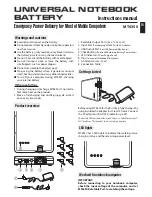
4
Starting your computer
Press and hold the power button at the top of the keyboard (18) for a couple seconds.
After the computer does some boot-up things, you’ll see a Novell log-in screen asking you for a
username and password.
If you’re plugged in to the college network using an Ethernet cable from your laptop to a
network connection on the wall, you can enter your Novell username and your Novell password
(see page 12 for more details on what your Novell log-in might be). The computer will search
the various servers to validate your account and after a few moments your normal desktop will
appear.
When you’re not plugged into the college network using an Ethernet cable, you have to put a
checkmark in the box labeled
Workstation only
then enter your Novell username and
password. If you need internet access, you can use the college’s wireless network. See page 5
for more information on wireless.
Things you may need to plug in at this point
Ethernet cable – connects from left side of computer (7) to network port in wall.
Mouse – plugs into USB port (5) on right side of computer.
AC adapter – plugs into power connector (10) on back of computer.
ThinkVantage
The blue ThinkVantage button (17) launches the ThinkVantage Productivity Center which has
shortcuts to the help desk, webmail and wireless connectivity.
Next to the ThinkVantage button, there are dedicated buttons to mute, lower, and raise the
computer’s sound output levels.
Your laptop has built-in speakers (just under the front of the keyboard) and a built in
microphone (the two little holes below the Fn key bottom left of the keyboard.)
The microphone jack (5) only accepts microphone level inputs. You can’t connect a line level
signal such as the output from a tape recorder, or the headphone jack of a portable stereo. It
will distort.
The little blue icons on some of the F keys at the top of the keyboard mean they have
additional functions. You select those functions by holding down the blue Fn (Function) button
at the bottom left of the keyboard, then pressing the appropriate F key.
For example:
Fn-F3 turns the computer’s monitor off. Press any key to turn it on again. If you’re connected
to an LCD projector, you can use Fn-F3 to temporarily darken the projection screen.
Fn-F4 puts the computer to sleep and wakes it up again
Fn-F5 turns on your computer’s wireless antenna on or off
Fn-F7 sends the computer’s screen image to the VGA port on the right side (and through that to
an LCD projector or external monitor)
Fn- F12 puts the computer into hibernate mode – it’s like shutting down, but your open
documents will come up again when you wake it up
Fn- Home and Fn-End make the computer screen brighter or darker (darker conserves battery
power)
Fn- PgUp turns on a little light built into the top of the screen (for when you’re doing
presentations in the dark)
Fn-spacebar enlarges the screen view (useful when you want to show small text at giant size)
































